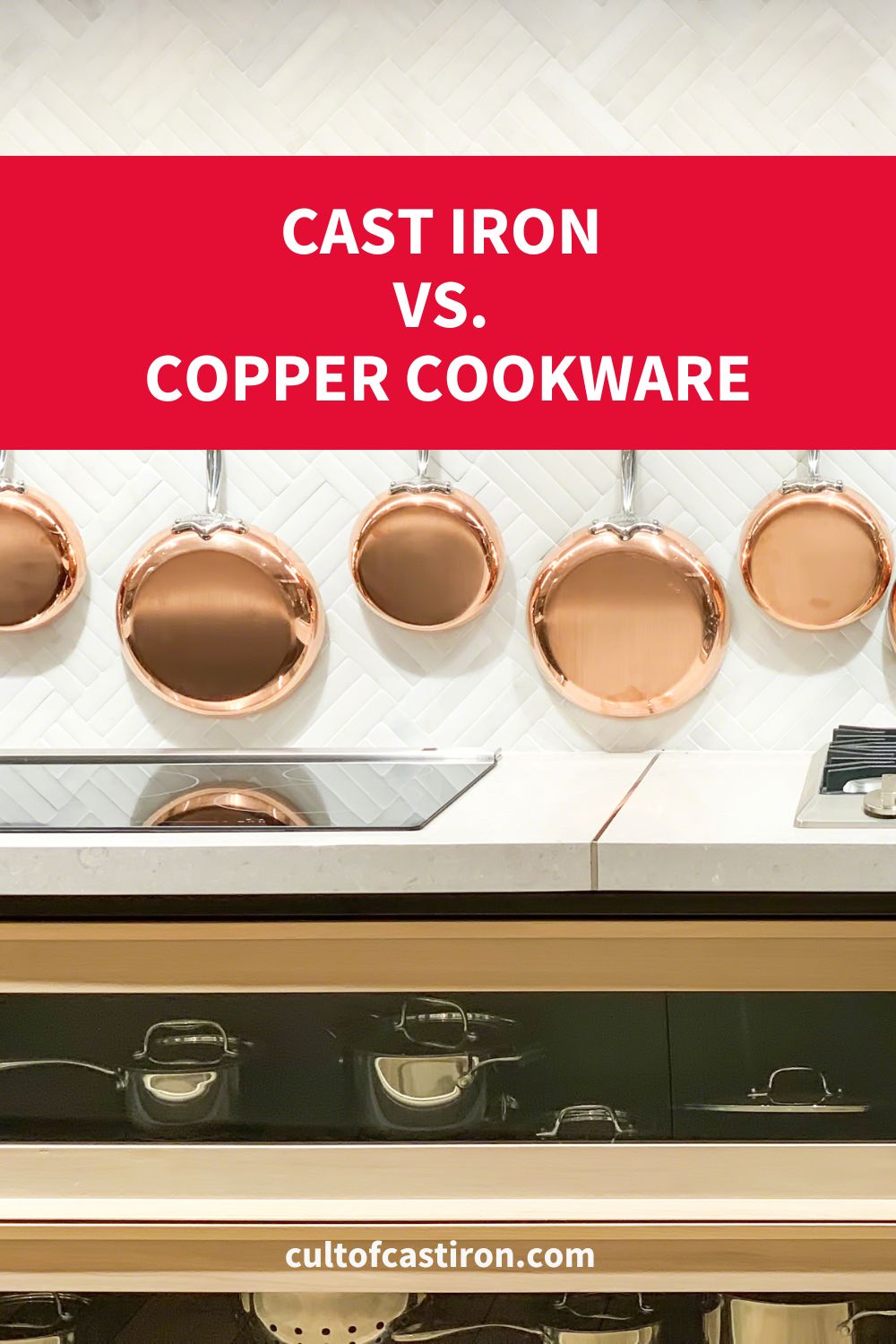Cast iron and copper cookware are great choices not only for cooking, but also for those who curate old-timey aesthetics in their home decor and lifestyle.
Each offers distinct advantages that cater to different cooking styles and needs, and understanding the differences between these materials can help you make an informed decision for your kitchen. In this article, we’ll explore how cast iron and copper cookware compare in terms of heat conduction, durability, maintenance, versatility, weight, non-stick quality, and price, giving you the insights needed to choose the best option for you home cooks.
Cast Iron vs. Copper Cookware
Heat conduction, retention, and distribution
Copper is highly regarded for its superior heat conduction characteristics. In fact, it has the highest thermal conductivity coefficient compared to the other metals used to make cookware. Meanwhile, cast iron sits near the bottom of that scale.
| Material | Thermal Conductivity (W/mK) |
| Copper | 386 |
| Aluminum | 239 |
| Tin | 73.3 [1] |
| Cast Iron | 55 |
| Carbon Steel | 45 |
| Stainless Steel | 25 |
Since copper is on the higher end of the thermal conductivity spectrum, it means that it can quickly respond to temperature changes. While copper pans need a coating of tin or stainless steel — metals that have significantly lower thermal conductivity values compared to copper — for them to be useable, this layer is thin enough to not affect the conduction of heat by much.
Moreover, this trait, along with its thinner construction, ensures that heat is distributed along the surface evenly, so you’re less likely to encounter hotspots. This makes copper ideal for delicate dishes that require careful temperature management.
On the other side of the scale, we have cast iron.
Cast iron, by virtue of its metallurgical properties and its thicker construction, is a poor thermal conductor. It heats slowly, and distributed this heat unevenly along its surface. That is why it often takes a few minutes to properly pre-heat cast iron cookware. But once, it is heated, it holds its temperature for a long time. This makes it ideal for slow cooking techniques.
So, which one is better? To me, this is neither a positive or a negative. You’ll just have to figure out which side you prefer.
Winner: It’s a draw.
Durability
There is no escaping it: cast iron is absolutely more durable compared to copper pans.
Cast iron may be brittle, but its solid and thick construction makes it highly resilient and can last for many generations when properly maintained. Apart from that, cast iron can also be subjected to a higher level of heat.
Cast iron has a melting point of 1,204°C (2,200°F) compared to copper’s 1,084°C (1,983°F). While the difference is not exactly large, the tin coating of copper pans have a relatively low melting point of around 450°F (232°C), which means that exposing it to high temperatures can cause the tin lining to melt or degrade. This can compromise the safety and effectiveness of the pan — though this is not a problem for stainless steel-coated copper pans.
Apart from its temperature limits, copper cookware can tarnish and scratch easily, and its thinner construction makes it more prone to denting compared to cast iron. However, proper care, handling, and maintenance can mitigate these issues.
Winner: Cast Iron
Maintenance
Both copper and cast iron cookware need proper care and maintenance to remain useful, but each requires it to varying degrees.
I’m pretty sure you’ve seen countless ‘cast iron is hard to maintain’ memes circulating on the internet. While there’s some truth to it, I think people make it out to be harder than it really is.
Maintaining cast iron requires regular seasoning to prevent rust and maintain its non-stick properties. Seasoning involves applying a thin layer of oil to maintain its natural, non-stick coating. You should do this after every use, and it this whole process does not take more than 5 minutes. More importantly, you can do all of this by yourself using common kitchen items.
https://cultofcastiron.com/cast-iron-seasoning-101
In contrast, copper cookware needs regular polishing to maintain its shine and prevent tarnishing. The lining must be protected from scratches to ensure safe cooking. While this coating can last for decades, you’ll have to find a tinsmith to have it recoated. Companies that offer re-tinning services are far and few between, and their prices are often high because of this.
Again, these are neither positives nor negatives. You’ll have to choose whether you prefer quick, relatively easy day-to-day maintenance with copper or minimal daily upkeep with cast iron, but potentially face the hassle and expense of re-tinning copper cookware in the long run.
Winner: Copper (it’s just a lot easier day-to-day)
Versatility
If you need a workhorse that can handle a wide array of cooking techniques across different heat sources, cast iron is the clear winner.
Its robust construction allows it to be used on virtually any heat source, including stovetops, ovens, grills, and even over an open flame. You can even use it on top of an induction cooker!
On the other hand, copper is better suited for precision cooking on the stovetop as it gives you the ability to make precise temperature adjustments with its superior heat conduction characteristics.
However, copper pans are often not recommended for high-temperature oven use as it can mess with its tin lining (stainless steel lining are much less of an issue, though).
Copper is also not ferromagnetic, so you can’t use them on induction stoves. Grilling is also out of the question, as it will ruin the aesthetics of the copper pan.
Winner: Cast Iron
Also read: Can Cast Iron Be Used on an Induction Cooktop? Yes – Here’s Why
Weight
Weight is one of those things that most think will not be a significant factor when it comes to cooking, but it can significantly impact your cooking experience. If your pan is heavy, it can be a challenge lifting and maneuvering it, especially when filled with hot food. Cooking techniques like flipping and tossing are also significantly harder to do in heavier pans.
With all that in mind, those who prefer their cookware on the lighter end should not choose cast iron. There’s no getting around it—cast iron is heavy. The heft of a cast iron skillet or Dutch oven is one of its defining characteristics, and while this weight contributes to its excellent heat retention and durability, it can be a pain to move around in the kitchen.
In contrast, copper cookware is much lighter and more manageable, making it a more user-friendly option for many home cooks. The lighter weight of copper pots and pans makes them easier to handle, whether you’re flipping delicate crepes, moving a sauté pan around on the stove, or pouring sauces.
Winner: Copper
Non-stick quality
When it comes to non-stick performance, cast iron holds a unique position. A well-seasoned cast iron pan can develop an impressive non-stick surface that rivals even modern non-stick coatings. The seasoning process involves building up layers of polymerized oil on the pan’s surface, creating a natural, non-stick coating over time. This makes cast iron ideal for cooking tasks where sticking is a concern, such as frying eggs, searing meats, or making pancakes. However, achieving and maintaining this non-stick quality requires regular seasoning and careful use. If not properly maintained, the seasoning can degrade, leading to sticking issues. While some might find the upkeep demanding, many enthusiasts see it as a rewarding ritual that enhances the pan’s performance and longevity.
Copper cookware, on the other hand, is not inherently non-stick. This means that with copper cookware, you might need to rely more on cooking techniques, like using sufficient oil or butter, to prevent sticking, especially with stainless steel-lined pans.
Winner: Cast Iron
Also read: Cast Iron Seasoning 101: Everything You Need to Know
Price
Price is often a decisive factor when choosing cookware, and here, cast iron and copper present two distinct options that reflect their respective qualities and craftsmanship.
| Material (10-inch Pan) | Price (at Low Price Point) |
| Copper (11-inch) | USD80 |
| Carbon Steel | USD40 |
| Aluminum (with Teflon) | USD35 |
| Stainless Steel | USD30 |
| Cast Iron | USD20 |
One of the most appealing aspects of cast iron cookware is its affordability. Compared to other premium cookware materials, cast iron is generally much more budget-friendly. Apart from the affordability of cast iron as a raw material, it is also relatively simple to make at scale, which plays a part in its affordable prices.
On the opposite end of the spectrum, copper cookware is often seen as an investment due to its higher price. Copper is more expensive to produce, and are significantly rarer than cast iron. Additionally, the maintenance required to keep copper cookware in top condition—such as regular polishing and occasional re-tinning—can add to the overall cost over time.
Winner: Cast Iron
Also read: How Are Cast Iron Cookware Made?
Conclusion
Both cast iron and copper cookware offer unique advantages that cater to different cooking styles and preferences. Ultimately, the best cookware for you is the one that complements your cooking style and enhances your kitchen experience. But to sum it up:
| Criteria | Copper Cookware | Cast Iron Cookware | Winner |
|---|---|---|---|
| Heat Conduction, Retention, and Distribution | Excellent heat conduction, quick response to temperature changes. Even heat distribution, but requires a tin or stainless steel lining. | Poor heat conduction, slow to heat but excellent heat retention. Even distribution takes time. | Draw |
| Durability | Prone to tarnishing, scratching, and denting. Tin lining can degrade at high temperatures. | Extremely durable, can last generations, and withstands higher temperatures. | Cast Iron |
| Maintenance | Requires regular polishing and re-tinning, but easy day-to-day upkeep. | Requires regular seasoning to maintain non-stick properties. | Copper |
| Versatility | Ideal for precision cooking on stovetops, not suitable for induction or grilling. | Suitable for various cooking techniques and heat sources, including induction. | Cast Iron |
| Weight | Lightweight and easy to handle. | Heavy, which can be cumbersome to maneuver. | Copper |
| Non-Stick Quality | Not inherently non-stick; requires proper cooking techniques. | Develops a natural non-stick surface with seasoning. | Cast Iron |
| Price | Expensive, considered an investment. | Affordable and budget-friendly. | Cast Iron |
The overall winner for this one is cast iron. But again, use this as a guide if you are starting from carte blanche and you need to choose between one or the other as your first set of pans. Beyond that, there’s nothing stopping you from getting both for your kitchen!
If you’re still hungry for more info about cast iron and other cookware made from carbon steel, stainless steel, copper, and aluminum, then be sure to check out the rest of the Cult of Cast Iron blog!

Miguel is a cast iron enthusiast from Cavite, Philippines. He works in the digital marketing field as a content marketing strategist. On the side, he manages a small online bookstore and tends to his plants.

